Smith, Rae M., Dalton, Desiré L., Mwale, Monica, Nupen, Lisa Jane, Pretorius, Chantelle, Bojko, Jamie, Labuschagne, Kim, Russo, Isa-Rita M.  ORCID: https://orcid.org/0000-0001-9504-3633 and Osinubi, Samuel T.
2023.
Assessment of genetic and morphological differentiation among populations of Diederik Cuckoo (Chrysococcyx caprius).
Ostrich: Journal of African Ornithology
94
(2)
, pp. 86-99.
10.2989/00306525.2023.2222230 ORCID: https://orcid.org/0000-0001-9504-3633 and Osinubi, Samuel T.
2023.
Assessment of genetic and morphological differentiation among populations of Diederik Cuckoo (Chrysococcyx caprius).
Ostrich: Journal of African Ornithology
94
(2)
, pp. 86-99.
10.2989/00306525.2023.2222230
|
|
Image (PNG) (Figure 3A)
- Supplemental Material
Download (30kB) |
|
Preview |
PDF
- Accepted Post-Print Version
Available under License Creative Commons Attribution Non-commercial No Derivatives. Download (480kB) | Preview |
|
Image (PNG) (Figure 3B)
- Supplemental Material
Download (28kB) |
|
![Figure 1: Sampling locations [thumbnail of Figure 1: Sampling locations]](https://orca.cardiff.ac.uk/161776/4.hassmallThumbnailVersion/Figure1.png)  Preview |
Image (PNG) (Figure 1: Sampling locations)
- Supplemental Material
Download (9MB) | Preview |
Preview |
Image (PNG) (Figure 2)
- Supplemental Material
Download (114kB) | Preview |
![Figure 3 [thumbnail of Figure 3]](https://orca.cardiff.ac.uk/161776/6.hassmallThumbnailVersion/Figure%203C_Rplot_Clade_PCA.png) 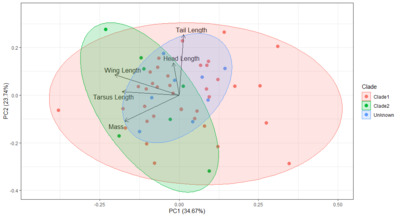 Preview |
Image (PNG) (Figure 3)
- Supplemental Material
Download (30kB) | Preview |
![Figure 4 [thumbnail of Figure 4]](https://orca.cardiff.ac.uk/161776/7.hassmallThumbnailVersion/Supplementary%20Figure_4%20A%20and%20B.jpg) 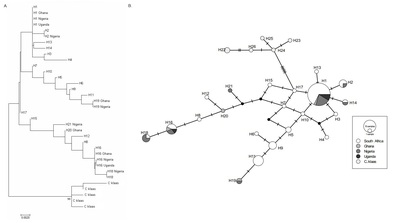 Preview |
Image (JPEG) (Figure 4)
- Supplemental Material
Download (128kB) | Preview |
![Figure 5 [thumbnail of Figure 5]](https://orca.cardiff.ac.uk/161776/8.hassmallThumbnailVersion/Supplementary%20Figure_5%20A%20and%20B.jpg) 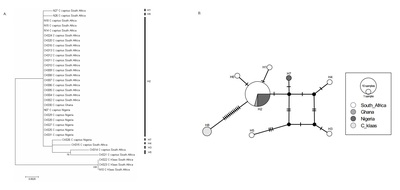 Preview |
Image (JPEG) (Figure 5)
- Supplemental Material
Download (156kB) | Preview |
![Figure 6 [thumbnail of Figure 6]](https://orca.cardiff.ac.uk/161776/9.hassmallThumbnailVersion/Supplementary%20Figure_6.jpg)  Preview |
Image (JPEG) (Figure 6)
- Supplemental Material
Download (1MB) | Preview |
![Figure 7 [thumbnail of Figure 7]](https://orca.cardiff.ac.uk/161776/10.hassmallThumbnailVersion/Supplementary%20Figure%201_16S.png) 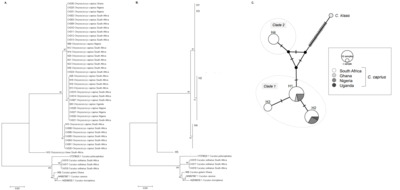 Preview |
Image (PNG) (Figure 7)
- Supplemental Material
Download (176kB) | Preview |
![Figure 8 [thumbnail of Figure 8]](https://orca.cardiff.ac.uk/161776/11.hassmallThumbnailVersion/Supplementary%20Figure%202_12S.png) 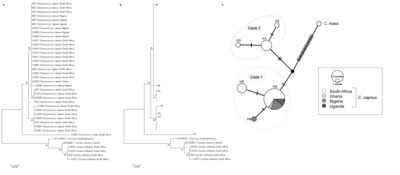 Preview |
Image (PNG) (Figure 8)
- Supplemental Material
Download (185kB) | Preview |
Abstract
The Diederik Cuckoo Chrysococcyx caprius is an African species widely distributed south of the Sahara, which migrates seasonally between breeding and nonbreeding sites. It is currently unknown whether the species consists of a single panmictic population or if it is genetically structured. To investigate this, we analysed sequence variation in three mitochondrial and two nuclear gene regions in combination with morphological measurements in specimens from four localities. Phylogenetic relationships were estimated using maximum-likelihood methods and included samples of Klaas’s Cuckoo Chrysococcyx klaas, Red-chested Cuckoo Cuculus solitarius, and African Cuckoo Cuculus gularis. Haplotype networks and analysis of molecular variance were used to characterise the spatial distribution of genetic diversity. A principal component analysis was performed to investigate morphological variation among localities. Molecular analysis identified two divergent mitochondrial lineages, which were found to occur in sympatry in one South African locality (Limpopo Province). The magnitude of divergence between versus within these lineages was low (0.4–1%) yet significant (FST: 0.84–0.88). Lack of apparent phylogeographic structure provides support for the absence of physical barriers to gene flow in this species. The divergent mitochondrial lineages did not differ in morphological measurements. The emergence and persistence of shallow mitochondrial divergence among sympatric lineages in the Diederik Cuckoo could be linked to maternal divergence in host selection of these brood parasites — a hypothesis requiring additional data to be tested.
| Item Type: | Article |
|---|---|
| Date Type: | Publication |
| Status: | Published |
| Schools: | Schools > Biosciences |
| Publisher: | Taylor and Francis Group |
| ISSN: | 0030-6525 |
| Date of First Compliant Deposit: | 15 August 2023 |
| Date of Acceptance: | 25 May 2023 |
| Last Modified: | 10 Nov 2024 07:30 |
| URI: | https://orca.cardiff.ac.uk/id/eprint/161776 |
Actions (repository staff only)
 |
Edit Item |




 Altmetric
Altmetric Altmetric
Altmetric